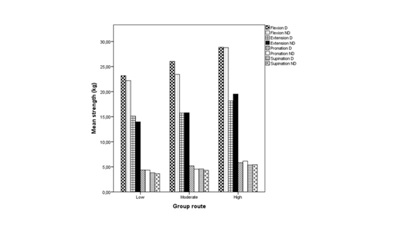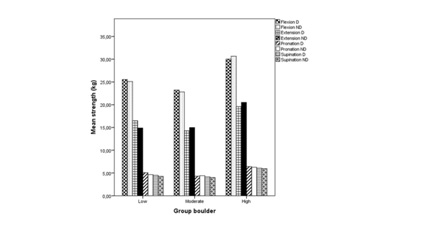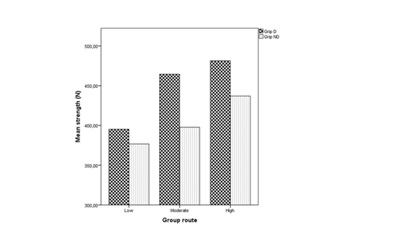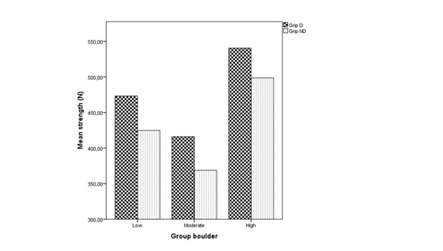Abstract
Background
Elbow strength ratios in relation to performance level, in male and female climbers, are scarcely documented. The aim of this study was to investigate elbow muscle strength, strength ratio and hand grip strength in climbers and its potential relationship to performance level.
Hypothesis
We hypothesized that there is a relationship between performance level and various strength variables and that greater strength is associated with higher performance level.
Study design
Cross-sectional
Level of evidence
4
Methods
Forty-four men (50%) and women (mean age 27.7±6.8 years), with a mean climbing experience of 5.8±5.2 years, participated in the study. Each climber performed upper-extremity strength tests using the Isobex 3.0® and Grippit® and a questionnaire concerning data relating to climbing experience and her/his training routines.
Results
Climbing experience, in years, in relation to route level of climbing yielded an overall significant effect (p=0.043). No significant differences were found between the low, moderate and high route climbing groups when it came to time spent climbing (p > 0.05). Elbow muscle strength showed significant correlations to boulder climbing level (p < 0.05). No relationships were found between route performance level and the muscle strength tests (p > 0.05). No correlations were found between grip strength and performance level in neither the route or the boulder group.
Conclusion
The present study suggests that elbow muscle strength is an important factor for boulder performance in contrast to route climbing performance.
Clinical relevance
Boulder climbers might benefit from strength training whereas the values of strength gains for route climbers are not clear.
Keywords
Boulder; Grip strength; Muscle strength ratio; Route climbing
INTRODUCTION
Rock climbing continues to increase in popularity [1,2]. The two main disciplines of rock-climbing are bouldering and route/rope climbing. The same grading system is used to describe the overall technical difficulties and strenuousness of specific boulder or route problems. The grading system is called the French sport-climbing grading scale and consists of a number (starting at 1 and is open ended), letter (a/b/c) and possibly a plus symbol. A low number indicates an easier problem/route and an “a” indicates an easier level than “b”, than “c”. A plus symbol after the letter indicates one level harder. For example, 6a is easier than 6a+ n and 6b+ easier than 6c. Bouldering involves climbing on boulders, by definition up to 6 meters height with neither rope nor harness but with a so-called “crash pad” to land on. Route/rope climbing entails climbing with a harness and rope on a rock wall. There is no limit as to how long a route can be but usually it is between 10-30 meters. Bouldering tends to be more explosive (using more explosive strength and rapid movements) and power-focused whereas route climbing tends to demand more endurance [3]. The relationship between climbing performance and muscle strength and endurance has previously been investigated. In one study, boulder grade was moderate related to sport-specific finger strength [4]. In another study examine maximum strength, no correlations were found between wrist and finger absolute strength and climbing level [5]. However, when analyzing relative strength (strength relative to bodyweight), moderate correlations were found. Despite the available literature, there seems to remain a paucity of information regarding muscle imbalance and strength ratios (the agonist-antagonist strength relationship) in climbers. Muscle imbalance has been proposed to be involved in the etiology of various musculoskeletal pain syndromes [6] and persistent imbalance may result in the development of degenerative changes [7]. Some studies report that muscle imbalances between synergistic and antagonistic muscle recruitment may be a factor for pain [8]. Although specific muscles may not play a direct role in the origin of overuse tendinopathies such as golfer’s and tennis elbow, the muscles involved in elbow flexion and extension may play a contributing role to the muscular balance in the upper extremity [6].
When it comes to strength ratio, one study investigated the isokinetic strength profiles and work ratios of the shoulder internal and external rotators in sport climbers compared with non-climbers [9]. A significant difference in the strength ratio was found between groups in favor for the climbers. Still, few data exist when it comes to elbow strength ratio in climbers. A basic motivation to investigate strength ratios in the climber’s elbow is that overuse-type injuries such as “tennis” and “golfer’s” elbow commonly affect climbers [10]. Since studies performed in Sweden have mostly been on male populations and earlier studies have recommended that future research include greater proportion females, this study aimed to contain a more even distribution between the sexes. Taken together, there is a need for further investigation of strength ratios, especially elbow strength, in both male and female climbers.
The purpose of the current study was to examine isometric elbow muscle strength and grip strength in climbers and to describe strength-ratios in the elbow among climbers. The study also aimed to investigate possible differences in strength ratios, as well as elbow and grip strength, in climbers of different performance levels. We hypothesized that there is a relationship between performance level and various strength variables.
METHODS
Subjects
The research population consisted of 44 rock climbers (22 route and 22 boulders, 50% women), who trained at one of Gothenburg’s three largest indoor climbing gyms in Sweden. Recruitment took place via information posters, personal contacts and word of mouth. Information posters included space for subjects’ names in order to be contacted for more information. Verbal and written information was given to each subject and all subjects signed a free and informed consent term. Inclusion criteria were: Rock climbers (indoor and outdoor), between the age of 18 and 45 who had climbed at least twice a week during 11 of the past 12 months. Subjects with illness or injury of the musculoskeletal system during the past 3 months, which had hindered the subject from training, were excluded. Demographic data is presented below in table 1 based on route climbing level and in table 2 based on boulder climbing level.
| Level of Climbing |
Low |
Moderate |
High |
Total Sample |
| (French grade) |
(5a ≥ 6c) |
(6c+ ≥ 7a+) |
(7b ≥ 8a) |
(5a-8a) |
| (n=7) |
(n=7) |
(n=8) |
(n=22) |
| Age x? (yrs) |
25.9 (4.3) |
28.0 (7.7) |
29.0 (8.2) |
27.7 (6.8) |
| Experience (yrs) |
3.1 (1.2) |
4.4 (2.9) |
9.3 (7.0) |
5.8 (5.2) |
| Weight (kg) |
66.5 (14.5) |
67.0 (4.1) |
63.7 (7.5) |
65.6 (9.3) |
| Height (cm) |
177.43 (8.70) |
173.7 (4.3) |
173.5 (6.0) |
174.8 (6.5) |
| Hrs/wk climbing |
5.2 (1.2) |
7.1 (2.2) |
8.8 (3.6) |
7.1 (3.0) |
| Hrs/wk sport-specific |
2.3 (6.1) |
0.5 (0.6) |
1.3 (2.2) |
1.3 (3.6) |
| Hrs/wk other training |
11.6 (18.0) |
2.4 (3.6) |
1.4 (2.0) |
5.1 (11.1) |
| Women (n) |
5 |
3 |
3 |
11 |
| Men (n) |
2 |
4 |
5 |
11 |
| R-handed (n) |
6 |
7 |
7 |
20 |
| L-handed (n) |
1 |
0 |
1 |
2 |
Table 1: Background variables displayed by route climbing groups: x? (SD). N=22.
| Level of Climbing |
Low |
Moderate |
High |
| (French grade) |
(5a ≥ 6a+) |
(6b ≥ 7a+) |
(7b ≥ 8a) |
| (n=8) |
(n=8) |
(n=6) |
| Age x? (yrs) |
25.9 (3.9) |
29.3 (8.0) |
28.0 (8.6) |
| Experience (yrs) |
2.9 (1.3) |
6.4 (6.8) |
8.8 (4.5) |
| Weight (kg) |
66.3 (13.4) |
63.3 (7.4) |
67.8 (4.1) |
| Height (cm) |
177.1 (8.1) |
171.3 (5.7) |
176.5 (3.1) |
| Hrs/wk climbing |
5.1 (1.8) |
8.9 (3.1) |
7.5 (2.8) |
| Hrs/wk sport-specific |
2.0 (5.7) |
1.5 (2.1) |
0.2 (0.4) |
| Hrs/wk other training |
10.1 (17.2) |
2.6 (3.6) |
1.3 (1.5) |
| Women (n) |
5 |
6 |
0 |
| Men (n) |
3 |
2 |
6 |
| R-handed (n) |
7 |
7 |
6 |
| L-handed (n) |
1 |
1 |
0 |
Table 2: Background variables displayed by boulder climbing groups: x? (SD). N=22.
Procedures
Measurements took place in a secluded room at a climbing gym in the Gothenburg area. Each subject filled out a questionnaire concerning training, experience and injuries before the test session. The questionnaire comprised 8 questions, concerning data relating to the subjects’ gender, age, weight and height, climbing experience, number of training hours per week and her/his training routines. Subjects were instructed to be warmed up prior to testing, either by performing their usual warm-up routine, traversing on the climbing wall or following a suggested warm-up of 5 min total including jogging, shoulder and elbow movements. Instructions concerning body position and the necessity of not engaging in compensatory movements during testing were given and information was given that the best test result would be used and any of lower quality would be discarded. Weight and height were measured. The whole procedure took between 45 minutes and 1 hour. Instructions were given in Swedish to Swedish speaking and in English to those with a native language other than Swedish (n=5).
Measures
The isometric elbow strength in flexion, extension, pronation and supination was assessed with the Isobex 3.0® [11]. The Isobex® is a portable isometric dynamometer. The unit of measurement when using Isobex 3.0® is kilograms, one decimal and the “total” value was used, which is an average of the five testing seconds. A Grippit® (AB Detektor, Gothenburg, Sweden) was used to measure grip strength. Grippit® is an electronic instrument which measures isometric grip strength, with high test-retest reliability and high precision [12,13]. It has a standardized handle with the following measurements: 45 mm deep, 27 mm wide and a circumference of 125 mm. The unit of measurement with the Grippit® is Newton and it measures maximum and average values for 10 seconds, with values ranging 0-999 Newton. “Max” value, no decimals, from the Grippit® was used, which the maximum value is obtained at some point during the ten testing seconds. An analogue scale was used to measure weight, a tape measure fixed to the wall for height measurement.
The order of testing was the following: Elbow flexion, extension, pronation, supination, hand grip. Each isometric direction was measured first three times on the right, then three times on the left with 30 second rests between each trial. All measurements were made with the forearm semi-pronated for the purpose of uniformity. In order to measure elbow strength, a wooden staff with a diameter of 22 mm and length 215 mm was attached by a semi static cord attached to the Isobex 3.0®. The staff was marked for placement of third phalange (middle finger) at 125 mm from the top. This was to standardize measurement, making the moment arm the same for all subjects. The staff was attached at 40 mm from the top through a drilled hole by a semi-static cord of 2 mm diameter. This cord was attached to a semi-static cord of diameter 4 mm, 750 mm long (to its attachment) to the Isobex® for measurement of pronation and supination. A massage bench of model Tarsus MA (50 cm wide), was used for placing the subject when measuring elbow extension, an office chair with adjustable height and a small table of height 57 cm were also present.
Elbow flexion
The subject was tested in the seated position, elbow at a 90-degree angle, fore-arm semi-pronated (thumb up). The subject was given three trials with 30 seconds rest between trials. First the right arm was tested and then the left.
Elbow extension
The subject was tested in the supine position, elbow at a 90-degree angle, fore-arm semi-pronated (thumb up/cranial direction) (Figure 1). The subject was given three trials with 30 seconds rest between trials. First the right arm was tested and then the left.
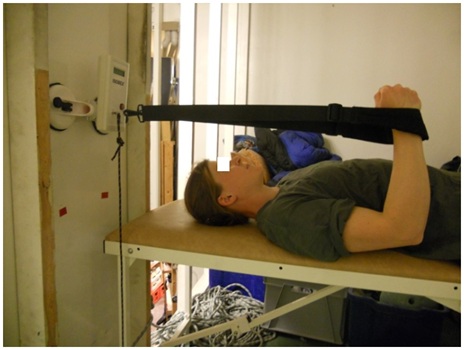
Figure 1: Elbow extension testing position with Isobex®.
Elbow pronation
The subject was tested in the seated position, elbow at a 90-degree angle, fore-arm semi-pronated (thumb up) (Figure 2). The subject was given three trials with 30 seconds rest between trials. First the right arm was tested, and then the left.
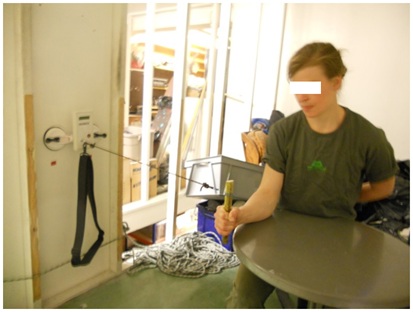
Figure 2: Elbow pronation testing position with Isobex®.
Elbow supination
The subject was in the seated position, elbow at a 90-degree angle, fore-arm semi-pronated (thumb up) (Figure 3). The subject was given three trials with 30 seconds rest between trials. First the right arm was tested and then the left.
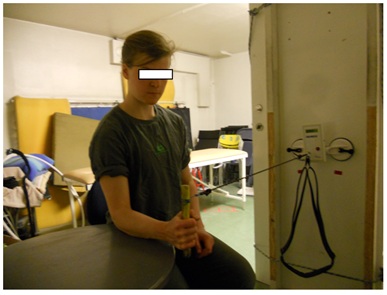
Figure 3: Elbow supination testing position with Isobex®.
Grip strength measurement
The subject was seated with 90 degrees elbow flexion when measuring grip strength. Subjects were instructed to grip as hard as they could after being given the verbal command “3, 2, 1 and go!” Subjects performed three trials on the right hand followed by three trials on the left hand. A rest interval of 30 seconds between trials was given and measurement started immediately after the verbal command to “go” was given.
Statistical analysis
The collected data were analyzed using descriptive statistics, non-parametric statistics (chi square) and Analyses of Variance (univariate ANOVAs). These analyses were used in order to assess the relationship between climbing level grouped into three groups (low, moderate, high-level) on the one hand and strength first based on route grade and then based on boulder grade on the other hand. Post-hoc Scheffe’s test employs pair wise group comparisons to detect differences between groups [14]. Post-hoc Scheffe’s test was used to analyse differences between groups concerning strength and strength ratio variables. In order to create groups as equal in number (n) as possible, cut-off points between “low, moderate and high-level” were arbitrary. For the groups based on route grade, low level was defined as route grade 5a ≥ 6c (n=7), moderate as 6c+ ≥ 7a+ (n=7) and high as 7b ≥ 8a (n=8). Based on bouldering grade, “low” was defined as bouldering grade 5a ≥ 6a+ (n=8), “moderate” as 6b ≥ 7a+ (n=8) and “high” level as 7b ≥ 8a (n=6). In addition, relationships between the muscle strength tests and boulder and route performance were also investigated using Spearman’s rank correlation coefficient. Strength ratios of the elbow were calculated by dividing each individual’s obtained value of strength in “Extension” by their obtained value in “Flexion” (E/F). Then their strength value in “Supination” was divided by “Pronation” (S/P). These calculations yielded two strength ratios per arm and were used in order to investigate the relationship between performance level (grouping) and strength ratio. IBM SPSS Statistics 23.0 for Windows 32 bit software was used for all data analyses. The level of significance was set at p < 0.05.
RESULTS
ANOVAs were performed on all background variables (age, experience, weight, height, hours per week climbing, hours per week doing sport-specific training, hours per week doing non-climbing related training) both using the route groups and bouldering groups as basis for comparisons. The overall ANOVA analysis of the “experience” variable (climbing experience in years) in relation to route level of climbing yielded an overall significant effect (p=0.043). No significant differences were found between the low, moderate and high route climbing groups when it came to time spent climbing (p > 0.05). No significant difference was found for the ANOVA analysis of the “experience” variable (climbing experience in years) in relation to bouldering level (p=0.89). There was a significant difference between the low and moderate bouldering climbing groups when it came to time spent climbing (p > 0.03). No significant differences were found between the low and high or moderate and high groups (p > 0.05).
Muscle strength measurement
Correlations: Correlations were found between bouldering climbing level and non-dominant arm in elbow flexion (r=0.6, p=0.003), extension (r=0.51, p=0.016) and supination (r=0.63, p=0.002) as well as supination (r=0.57, p=0.006) and S/P in dominant arm (r=0.44, p=0.042). No significant relationships were found between bouldering climbing level and grip strength or E/F (p > 0.05). No significant relationship was found between route climbing level and any of the strength variables (p > 0.05).
Group based analysis: Values for the strength ratio measures in flexion, extension, supination, pronation, E/F and S/P, dominant and non-dominant arm respectively, as well as on the two measures of grip strength, separately for route and bouldering groups are presented data based on performance level in figure 4-7 and table 3. For the route groups, significant difference was found in elbow extension strength for non-dominant hand (p=0.018) between high and low-level climbers. No differences were found between the groups of route levels for any of the other strength data (Figure 4 and 6) (p > 0.05). In the bouldering groups, a significant difference in grip strength was found between low and high-level (p=0.033); non-dominant elbow flexion between low and high-level (p=0.016) and high and moderate level (p=0.025); dominant elbow extension between low and high-level (p=0.036) and high and moderate level (p=0.023); non-dominant elbow extension between low and high-level (p=0.002), and high and moderate level (p=0.005); dominant elbow pronation between low and high-level (p=0.047); dominant arm supination between low and high-level (p=0.002), and high and moderate level (p=0.003); and non-dominant arm supination between low and high-level (p=0.003) (Figure 5). Strength data for men and women separately are presented in table 4.
| |
Route |
Boulder |
| Low |
Moderate |
High |
Low |
Moderate |
High |
| (n=7) |
(n=7) |
(n=8) |
(n=8) |
(n=8) |
(n=6) |
| E/F D (kg) |
0.64 (0.1) |
0.61 (0.1) |
0.64 (0.1) |
0.62 (0.1) |
0.62 (0.1) |
0.66 (0.1) |
| E/F ND (kg) |
0.66 (0.1) |
0.69 (0.1) |
0.65 (0.1) |
0.67 (0.1) |
0.66 (0.1) |
0.67 (0.1) |
| S/P D (kg) |
0.97 (0.3) |
0.87 (0.2) |
0.96 (0.1) |
0.95 (0.3) |
0.93 (0.2) |
0.94 (0.1) |
| S/P ND (kg) |
0.91 (0.3) |
0.91 (0.3) |
0.92 (0.1) |
0.91 (0.2) |
0.94 (0.3) |
0.93 (0.1) |
Table 3: Mean values (M) and Standard Deviation (SD) on strength ratio measures presented by (route and boulder) performance level for Dominant (D) and Non-Dominant (ND) arm (n=44).
| Total Sample (n=44) |
Men (n=22) |
Women (n=22) |
| M (SD) |
Range |
M (SD) |
Range |
M (SD) |
Range |
| E/F right (kg) |
0.63 (0.08) |
0.50-0.77 |
0.62 (0.08) |
0.53-0.79 |
0.64 (0.08) |
| E/F left (kg) |
0.67 (0.08) |
0.53-0.87 |
0.69 (0.09) |
0.56-0.77 |
0.64 (0.06) |
| S/P right (kg) |
0.94 (0.21) |
0.56-1.20 |
0.85 (0.15) |
0.74-1.58 |
1.03 (0.23) |
| S/P left (kg) |
0.92 (0.23) |
0.62-1.10 |
0.87 (0.14) |
0.64-1.61 |
&0.98 (0.28) |
| Flex right (kg) |
25.9 (5.2) |
23.2-32.2 |
30.0 (2.9)* |
17.6-27.2 |
21.9 (3.4)* |
| Flex left (kg) |
24.7 (5.7) |
16.4-36.3 |
27.9 (5.9)* |
16.9-27.7 |
21.4 (3.3)* |
| Ext right (kg) |
16.4 (3.6) |
12.6-24.1 |
18.8 (3.4)* |
10.8-16.6 |
13.9 (1.7)* |
| Ext left (kg) |
16.2 (3.6) |
14.3-24.6 |
18.8 (3.1)* |
11.7-16.9 |
13.6 (1.7)* |
| Pron right (kg) |
5.1 (1.8) |
3.3-8.8 |
6.4 (1.6)* |
2.4-5.5 |
3.8 (0.9)* |
| Pron left (kg) |
5.1 (1.8) |
4.2-9.2 |
6.4 (1.5)* |
3.1-5.5 |
3.8 (0.6)* |
| Sup right (kg) |
4.6 (1.4) |
2.7-6.9 |
5.4 (1.4)* |
2.5-4.9 |
3.7 (0.7)* |
| Sup left (kg) |
4.4 (1.3) |
2.6-6.6 |
5.3 (1.2)* |
2.5-5.0 |
3.6 (0.8)* |
| Grip right (N) |
461.4 (103.6) |
382-661 |
515.3 (84.6)* |
295-596 |
407.6 (95.0)* |
| Grip left (N) |
415.3 (98.0) |
356-700 |
468.8 (95.3)* |
251-464 |
361.8 (69.4)* |
Table 4: Strength data and ratios between muscle groups in the elbow.Values are Mean (M) range and Standard Deviation (SD).*Difference between men and women.
Figure 4: Elbow strength values for different levels of route climbers.
Figure 5: Elbow strength values for different levels of boulder climbers..
Figure 6: Grip strength values for different levels of route climbers
Figure 7a: Grip strength values for different levels of boulder climbers.
DISCUSSION
The present study presents data on isometric elbow and hand grip muscle strength in climbers in the aspects of performance level. To our knowledge, this is the first study reporting data on elbow strength and elbow strength ratio. The main observation of the present study was that associations between muscle strength and performance level only existed in the boulder climbers. Correlations were found between bouldering climbing level and elbow flexion, extension and supination and the strength ratio S/P. No significant relationship was found between route climbing level and any of the strength variables (p > 0.05). One current study has reported a correlation between climber’s competence and the relative finger strength test (r=0.7) [15], whereas another found no correlation between maximum wrist and finger strength in recreational climbers [5]. In the present study we found no correlation between climbing level and grip strength. Differences in the outcome of the strength measurements could depend on several factors such as different assessments of strength and/or different levels of climbing performance. Why were there no significant relationships for the route climbers when considering performance level and muscle strength measurements? A possible explanation of this finding is that route climbing is a complex sport where technique, endurance and psychology are just as important as strength [3]. Boulder performance level might be more affected by muscle strength since bouldering is a more explosive form of climbing [3]. According to previous studies there is a strong relationship between explosive exercises and exercises for maximum strength [16,17]. Hence, bouldering might demand more maximum strength, compared to route climbing and the methods of measurement employed in this study might have been sensitive to this factor. In a study by Fanchini et al. [18], a large difference was observed between boulder and route climbers for rate of force development of finger flexors. In addition, another study has provided a biomechanical signature of the sub-discipline with an explosive profile for boulder climbers and either a weak and quick or slow profile for route climbers [19]. However, the skewed gender distribution in the boulder level groups, in the present study, might influence the results. In the high-level boulder group there were six men and zero women. Further research on bouldering men and women separately could shed light on the subject. When it comes to the route climbers, other mechanisms could be more important regarding the performance aspect, such as cognitive skills. According to previous research, the fundamentals explaining performance in climbing is technical, physical and mental characteristics [3]. Seeing a climbing wall activates a motor, embodied simulation, which relies on motor competence. In a study by Magiera et al. [20], key factors for performance in route climbers is the mental characteristics which contribute with approximately 25% of the capacity. In another study, it was revealed that the psychological states prior elite climbing competition appeared to be an important factor in determining success, even when differences in baseline ability were taken into account [21], no data exists, to our knowledge, on mental characteristics when it comes to boulder performance. We do not know if the mental feature might be of more importance to route than to boulder performance.
Taken together, the present study provides additional support for previous research that boulder climbers seem to be more explosive and that maximum strength is an essential item for these athletes. Future studies should be focusing on investigating both physical differences and sport-cognition relationship, in boulder and route climbing.
Only one relationship was found between performance level and Strength Ratio (S/P) in the boulder group and none were found in the group of route climbers. It has previous been noted a difference in shoulder internal and external strength ratio between climbers and non-climber [9]. In the study by Wong et al. [22], normalized work of shoulder internal and external rotators was greater in climbers than in non-climbers probably because the climbers more likely had well-developed shoulder muscles as a result of the greater demands placed on the upper limbs. The functional work ratio of eccentric internal rotation to concentric external rotation was also higher in the climbers than in the non-climbers, implying that the climbers had strong eccentric internal rotation [9]. However, no data on different performance levels of climbing is provided in the study by Wong et al. [22]. In addition, to our knowledge there is no previous research investigating elbow strength ratios in climbers. Thus, comparing results of the present study to other studies are unfeasible in the matter of elbow strength ratio.
We noted that the variance within each group (low, moderate, high) was fair. The grouping (low, moderate, high) was done on a continuous variable dimension. Thus, there were no intervals between groups “low”, “moderate” and “high”. This may have made the groups more similar to each other than if intervals had been created between the groups. The (route climbing) groups did not differ from each other regarding background variables, apart from “experience” (years of climbing). The means for the low, moderate and high-level route climbing groups were approximately 3, 6 and 9 years of experience. The fact that Sheffe’s post hoc did not yield significant differences may be due to the large variance within the groups, especially the moderate level group. The climbers in the study were assigned a level of climbing group, based on the difficulty grade of either rope climbing or bouldering that they reported as their highest achievement. It is always difficult to decide what makes one climber better than another. Especially in a sport such as climbing, where in addition to spanning very different disciplines (bouldering, rope: Lead/top-rope, outdoor/indoor) there are many factors contributing to what grade a climber succeeds in reaching [3]. It is perhaps easier using indoor competitions as a gauge but climbing complicates this as it is a sport where competence and level are just as often measured outdoors in leisure climbing as in indoor competitions.
The current study aimed to include a more even distribution of the sexes and succeeded in doing so. Therefore, it may better represent climbers as a mixed population of both men and women. However, there may be underlying sex differences that affect results, such as the fact that when groups of low, medium and high-level climbers were created, the sex distribution was no longer 50%-50% within each group. Nevertheless, when comparing strength variables between men and women as an entire group, there were significant differences in all strength variables, except for the strength ratios, in advantage for the men.
Before strength testing was performed a discussion was held concerning what position the climber’s forearm should be in: Pronated (as in climbing, sport specific-position), supinated (as is usually used when measuring elbow flexion strength), or semi-pronated. The last alternative, semi-pronated, was chosen because it could be used in all of the measurements (flexion, extension, pronation, supination, grip), providing the experiment with uniformity. Semi-pronation is not sport-specific since the climber performs all movements with a fully pronated forearm. Semi-pronated “thumb up” position treats all subjects equally as full pronation may reflect differences in range-of-motion of the forearm in addition to actual strength differences. If full pronation was chosen as testing position, it would have been difficult to ensure that each subject pronated to the same extent, as opposed to semi-pronation: “Thumb up” position which is easier to control. A fully pronated position would however have been a more “sport-specific”, better reflecting the climber’s movements/strength on the wall. It is possible that changing the testing positions to fully pronated would not change test results, but to confirm this, research in this area needs to be done. The semi-pronated positioning of the forearm was decided on in an attempt to gather comparable data; both within-subject and between-subject. To gather data that reflects a climber’s strength in their sport-specific positions it would perhaps be more relevant to measure flexion and extension strength in a fully pronated position of the forearm. At the start of the study this was decided against because of the difficulty of instructing and ensuring that a fully pronated positioning of the forearm was kept throughout the measuring intervals. As it is easier for the test person to understand “thumb up towards the ceiling” and also for the researcher to ensure that this position is kept throughout measurement, than if another phrase such as “keep your forearm fully pronated” had been used, the “thumb up” was used. The Isobex® is standardized for strength measures in the shoulder [11]. In order to measure strength in muscle groups affecting the elbow joint, additional ways of measurement were created. It is possible that with a more reliable method of measurement, findings would differ. Also, the strength testing was measured in this order, which might have a systematic effect on the result. Thus, it is possible that the methods of measurement may not have been appropriate. We believe it was difficult to control the exact degree of pronation/supination while measuring pronation/supination strength. It was difficult to ensure (other than by verbal instruction) that it was purely pronation or supination strength being measured, and not a combination of elbow flexion and pronation/supination strength. Thus, validating these methods of measurement is recommended for future comparisons. The hand grip strength test was performed using Grippit® and measured using the standardized procedure [22] to ensure credibility to the results. Taken together, in a future study it would be useful to develop standardized ways of measuring elbow flexion and extension, and forearm pronation, supination in order to evaluate the findings in this study.
CONCLUSION
This study provides strength data for both route and boulder climbers that could be used when evaluating physical performance as well as muscle imbalance and overuse injuries to the forearm. The study suggests that elbow muscle strength is an important factor for boulder performance in contrast to route climbing performance. Boulder climbers might therefore benefit from strength training whereas the values of strength gains for route climbers are not clear. Further research with a larger sample is needed to establish the possible relation between strength and performance level and validated measures of elbow strength ratios.
CLINICAL RECOMMENDATIONS
This study suggests that elbow muscle strength is an important factor for boulder climbing performance but not in route climbing performance. Hence, boulder climbers might benefit from upper extremity strength training to improve physical performance. When it comes to route climbers, maximum elbow and grip strength were not related to climbing performance. Thus, we recommend that these athletes focus their attention towards other physical factors such as technique and muscle endurance.
ACKNOWLEDGEMENT
We would like to thank all the climbers who participated in this study, offering their time and energy. We would also like to thank the climbing gym which generously provided the space for testing to take place in.
REFERENCES
- Backe S, Ericson L, Janson S, Timpka T Rock (2009) Climbing injury rates and associated risk factors in a general climbing population. Scand J Med Sci Sports 19: 850-856.
- Johnson K (2016) Popularity of climbing gyms reaches new heights. The Daily Universe, Provo, USA.
- Goddard D, Neumann U (1993) Performance rock climbing. Stackpole Books, Mechanicsburg, USA.
- Mladenov L, Michailov M, Schoffl I (2009) Anthropometric and strength characteristics of world-class boulderers. Sports Medicine 4: 231-238.
- Schweizer A, Furrer M (2007) Correlation of forearm strength and sport climbing performance. Isokinetics and Exercise Science. 15: 211-216.
- Janda V (1993) Muscle strength in relation to muscle length, pain and muscle imbalance. In: Harms-Ringdahl K (ed.). Muscle strength. Churchill Livingstone, Edinburgh, UK.
- Hodges PW, Richardson CA (1976) Inefficient muscular stabilization of the lumbar spine associated with low back pain. A motor control evaluation of transversus abdominis. Spine (Phila Pa 1976) 21: 2640-2650.
- Comerford MJ, Mottram SL (2001) Movement and stability dysfunction-contemporary developments. Manual Therapy 6: 15-26.
- Larsson FM, S Muskelstyrka (2008) Styrkeförhållande och rörlighet i skuldra samt greppstyrka hos klättrare: Institutionen för arbetsterapi och fysioterapi. Göteborgs University, Gothenburg, Sweden.
- Saunders J (2017) Dodgy Elbows 2009, 2017. Blackheath, London, UK.
- Leggin BG, Neuman RM, Iannotti JP, Williams GR, Thompson EC (1996) Intrarater and interrater reliability of three isometric dynamometers in assessing shoulder strength. J Shoulder Elbow Surg 5: 18-24.
- Lagerström C, Nordgren B (1998) On the reliability and usefulness of methods for grip strength measurement. Scand J Rehabil Med 30: 113-119.
- Svantesson U, Nordé M, Svensson S, Brodin E (2009) A comparative study of the jamar® and the grippit® for measuring handgrip strength in clinical practice. Isokinet Exerc Sci 17: 85-91.
- Scheffe H (1963) The analysis of variance. In: Hays W (ed.). Statistics for Psychologists. Wiley, New York, USA.
- Ozimek M, Staszkiewicz R, Rokowski R, Stanula A (2016) Analysis of tests evaluating sport climbers’ strength and isometric endurance. J Hum Kinet 53: 249-260.
- Augustsson SR (2013) Maximum strength in squats determines jumping height in young female volleyball players. The Open Sports Science Journal 6: 41-46.
- Wisloff U, Castagna C, Helgerud J, Jones R, Hoff J (2004) Strong correlation of maximal squat strength with sprint performance and vertical jump height in elite soccer players. Br J Sports Med 38: 285-288.
- Fanchini M, Violette F, Impellizzeri FM, Maffiuletti NA (2013) Differences in climbing-specific strength between boulder and lead rock climbers. J Strength Cond Res 27: 310-314.
- Laffaye G, Collin JM, Levernier G, Padulo J (2014) Upper-limb power test in rock-climbing. Int J Sports Med 35: 670-675.
- Magiera A, Roczniok R, Maszczyk A, Czuba M, Kantyka J, et al. (2013) The structure of performance of a sport rock climber. J Hum Kinet 36: 107-117.
- Sanchez X, Boschker MS, Llewellyn DJ (2010) Pre-performance psychological states and performance in an elite climbing competition. Scand J Med Sci Sports 20: 356-363.
- Wong EK, Ng GY (2009) Strength profiles of shoulder rotators in healthy sport climbers and nonclimbers. J Athl Train 44: 527-530.






